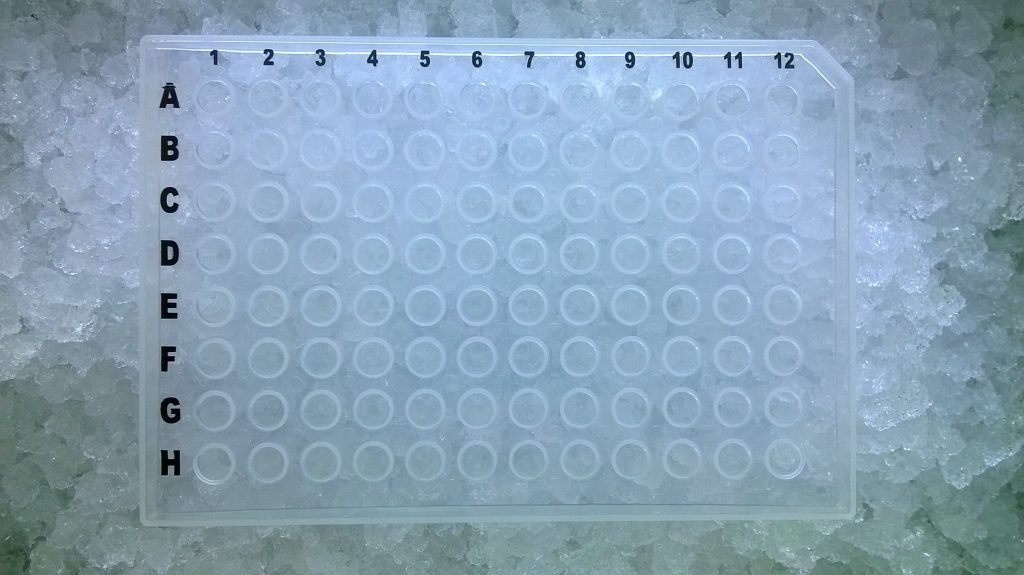Once we realised that most of our plate of Schistidium ITS2 amplifications had been successful, it was an easy decision to process them all for DNA sequencing. If a higher proportion had failed, we would have had to “cherry pick”, selecting and transferring the successful reactions into new tubes. Every sequencing reaction has a cost, and so deliberately sending a lot of failed reactions through the process, knowing that they won’t generate DNA sequences, is worth avoiding. However, transferring the reactions into new tubes is a meticulous job. In a plate of reactions, there are 96 wells arranged in 12 columns (1-12) and eight rows (A-H). The first sample is at 1A, then 1B, 1C, 1D, 1E, 1F, 1G, 1H, 2A… all the way to 12H. Imagine if the first failed sample is at 1B and the second at 1G – then we’d transfer 1A to 1A, 1C to 1B, 1D to 1C, 1E to 1D, 1F to 1E, 1H to 1F, 2A to 1G, etc… it’s easy to see that any interruptions can be fatal (this sort of task is why people in the lab sometimes have a “Do Not Disturb” sign stuck on the back of their lab coats). Thus, with only a few failures, we’re better keeping any liquid transfers simple (and manageable using a multichannel pipette).
After electrophoresis and visualisation of the Schistidium ITS PCR products under blue, or U.V., light, the next step is to clean up these PCR products. This is where we remove unincorporated primers and dNTPs from the reactions. In our PCRs, we added all the ingredients in excess, so that there was more of everything than the reaction needed. This might seem wasteful, but compared to the costs of the time and plastics that would be required to carefully optimise each reaction, throwing lots in and getting quicker results really isn’t too profligate.
When a PCR is successful, the primer (an oligonucleotide, or short single stranded DNA molecule) binds to the end of the region that is getting copied, and a new strand of DNA is synthesised from the end of the primer, incorporating the primer into the new strand. Thus, primers get used up. The building blocks for DNA synthesis, the nucleotides (As, Ts, Gs and Cs), are the dNPTs (deoxynucleoside triphosphates) that we added to the PCR reaction, again in excess. So even when we’ve built a lot of copies, we still have some primers and dNTPS that weren’t used up.
This didn’t matter when it came to looking at the results on the gel, but does become important in our next reaction, the sequencing PCR. In the sequencing PCR, we add just a single primer, and we add a very precise blend of nucleotides. So we don’t want to carry over primers and dNPTs from the previous reaction. There are several ways of removing these.
The cheapest is through ethanol precipitation of the synthesised DNA, where the unincorporated primers and dNTPs stay in solution and are thrown away. This is less easy to scale up to plates, and the moment where you turn it all upside down and toss the liquid out is rather worrying – the cost of plates of subsequent sequencing failure if the DNA pellets were lost is huge, and the pellets tend not to be visible.
For several years we used a column-based approach, a bit like our DNA extraction method, where the PCR product is bound to a membrane, and the unincorporated primers and dNTPs are flushed off it, before the PCR product is eluted back into solution.
However, the method we now use most regularly involves a combination of two enzymes, Eco1, and Shrimp Alkaline Phosphatase (SAP), which work elegantly in combination, and which involves methodology that is easily scalable for working with plates and multichannel pipettes. The Eco1 enzyme digests single-stranded DNA, so it cuts the primers up into individual nucleotides. The SAP enzyme dephosphorylates the nucleotides (the dNTPs) so that they are no longer functional. Thus after using these enzymes, although nothing has been physically removed from the tubes, the unwanted reagents have been rendered unusable. For convenience, we buy in a commercial combination of the two enzymes called ExoSAP-IT™, and add a small amount of that to our reactions (in this case, around 1 μl ExoSAP-IT to about 15 μl of PCR product).
The enzymes work best at 37ºC, and so the reactions were put on a heating block for 15 minutes. The enzymes are killed at a higher temperature, and so the next step was to heat the reactions to 80ºC for 15 minutes, to make sure that no viable enzymes are left to interfere with the sequencing reaction. After that, the plate of cleaned Schistidium ITS2 amplicons was left in the fridge until it was needed for the sequencing reactions.
Links to reports on Moss diversity in an artificial landscape, an EU Synthesys Access project with Dr Wolfgang Hofbauer at RBGE:
- Building on building mosses, a return to Schistidium in the built environment http://stories.rbge.org.uk/archives/24310
- Volunteering at the Botanics – bryophytes in our living landscape http://stories.rbge.org.uk/archives/24333
- Campylopus introflexus, an invasive alien on the glasshouse roof http://stor/ies.rbge.org.ukarchives/24359
- The trials and tribulations of a moss in the lab: DNA extraction http://stories.rbge.org.uk/archives/24399
- Copying moss DNA in the molecular lab http://stories.rbge.org.uk/archives/24451
- Gel electrophoresis of Schistidium ITS DNA http://stories.rbge.org.uk/archives/24531
- Cleaning the Schistidium PCRs

